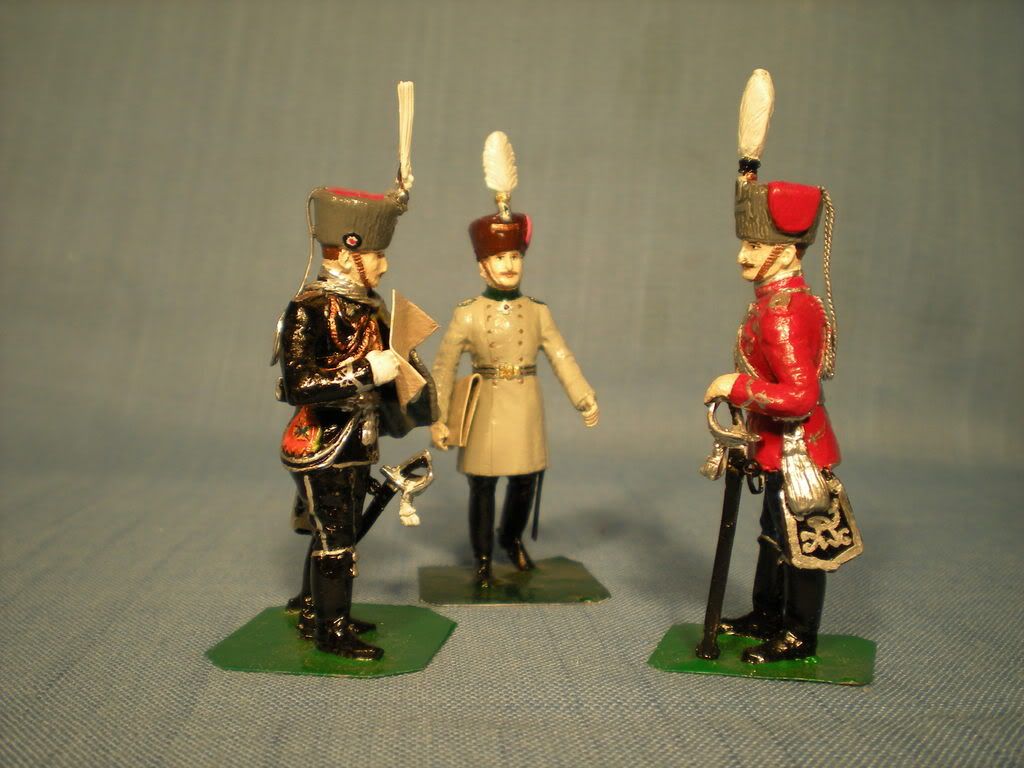theBaron
Major
- Joined
- Mar 27, 2008
- Messages
- 10,493
Hello again, everyone!
Tonight, I took some pictures of my Imperial Germans, as I was packing up the Christmas display.
These are the figures that can be seen in the background of my Christmas parade pics; I've collected and painted them, to go with Guard Corps' Kaiser Alexander Grenadier sets.
First up, the Kaiser himself, and his eldest daughter, Viktoria Luise:

The Kaiser is by Tradition, from their model soldier range. Viktoria Luise is a rarer casting, by my friend Mike Ferguson. She appears here in uniform as the Chefin, or colonel-in-chief, of the 2. Leib-Husaren-Regiment, the Second Bodyguard Hussars, one of the two regiments formed out of the old Death's-Head-Hussars of Frederick's army. The casting has a weak spot at the ankle; if I had to do it over, I'd pin her ankles with brass rod, to help support the weight of her body. That sounds bad; in real life, she wasn't bad-lookin', as German princesses go
Next up, three majors of the Reitenden Feldjägern:

and another angle:

These are Stadden figures. Among the distinctions of their uniform is the gold laced pouch belt, and the whistle and chain worn on the front.
This unit served as couriers for the Imperial household, and also the diplomatic corps. They traced their origins back to a small corps of mounted Jäger that Frederick the Great raised, to act as his couriers and mounted scouts, along with the Jäger zu Fuss, the rifles who served on foot. In Germany, it was those men, who were often foresters, gamekeepers, or their sons, who were usually the ones the local ruler could trust to act as his police. "Jäger" was synonymous with "policeman" in many German states until after the First World War, and as many of you K&C fans may know, the police wore a variation of the uniform. They still wear green uniforms today, though the shako was discarded in the early '50s.
Next up, three officers of hussars, all Stadden castings:



The figure in the red Attila or dolman is from the Blücher regiment (Blücher! Did I hear horses neighing? ). Seriously, this was the hussar regiment that a young Blücher served in, after his capture by the Prussians. Old Belling commanded it then, and it was maintained through the collapse in 1806, up to 1918.
). Seriously, this was the hussar regiment that a young Blücher served in, after his capture by the Prussians. Old Belling commanded it then, and it was maintained through the collapse in 1806, up to 1918.
The figure in the black uniform and pelisse is from the 1. Leib-Husaren-Regiment, the other one to be formed from the original Death's-Head regiment. In Tradition's catalog, I think they list this casting as a personality figure of the Crown Prince, who was the regiment's Chef. I had to add the plume; the original had broken off long before I got this figure. I used a bundle of wire to make the heron feathers.
The third Husar is from the Ziethen regiment, but with the Mantel, there's not a lot of detail to see.
More to follow....
Tonight, I took some pictures of my Imperial Germans, as I was packing up the Christmas display.
These are the figures that can be seen in the background of my Christmas parade pics; I've collected and painted them, to go with Guard Corps' Kaiser Alexander Grenadier sets.
First up, the Kaiser himself, and his eldest daughter, Viktoria Luise:

The Kaiser is by Tradition, from their model soldier range. Viktoria Luise is a rarer casting, by my friend Mike Ferguson. She appears here in uniform as the Chefin, or colonel-in-chief, of the 2. Leib-Husaren-Regiment, the Second Bodyguard Hussars, one of the two regiments formed out of the old Death's-Head-Hussars of Frederick's army. The casting has a weak spot at the ankle; if I had to do it over, I'd pin her ankles with brass rod, to help support the weight of her body. That sounds bad; in real life, she wasn't bad-lookin', as German princesses go
Next up, three majors of the Reitenden Feldjägern:

and another angle:

These are Stadden figures. Among the distinctions of their uniform is the gold laced pouch belt, and the whistle and chain worn on the front.
This unit served as couriers for the Imperial household, and also the diplomatic corps. They traced their origins back to a small corps of mounted Jäger that Frederick the Great raised, to act as his couriers and mounted scouts, along with the Jäger zu Fuss, the rifles who served on foot. In Germany, it was those men, who were often foresters, gamekeepers, or their sons, who were usually the ones the local ruler could trust to act as his police. "Jäger" was synonymous with "policeman" in many German states until after the First World War, and as many of you K&C fans may know, the police wore a variation of the uniform. They still wear green uniforms today, though the shako was discarded in the early '50s.
Next up, three officers of hussars, all Stadden castings:



The figure in the red Attila or dolman is from the Blücher regiment (Blücher! Did I hear horses neighing?
The figure in the black uniform and pelisse is from the 1. Leib-Husaren-Regiment, the other one to be formed from the original Death's-Head regiment. In Tradition's catalog, I think they list this casting as a personality figure of the Crown Prince, who was the regiment's Chef. I had to add the plume; the original had broken off long before I got this figure. I used a bundle of wire to make the heron feathers.
The third Husar is from the Ziethen regiment, but with the Mantel, there's not a lot of detail to see.
More to follow....















